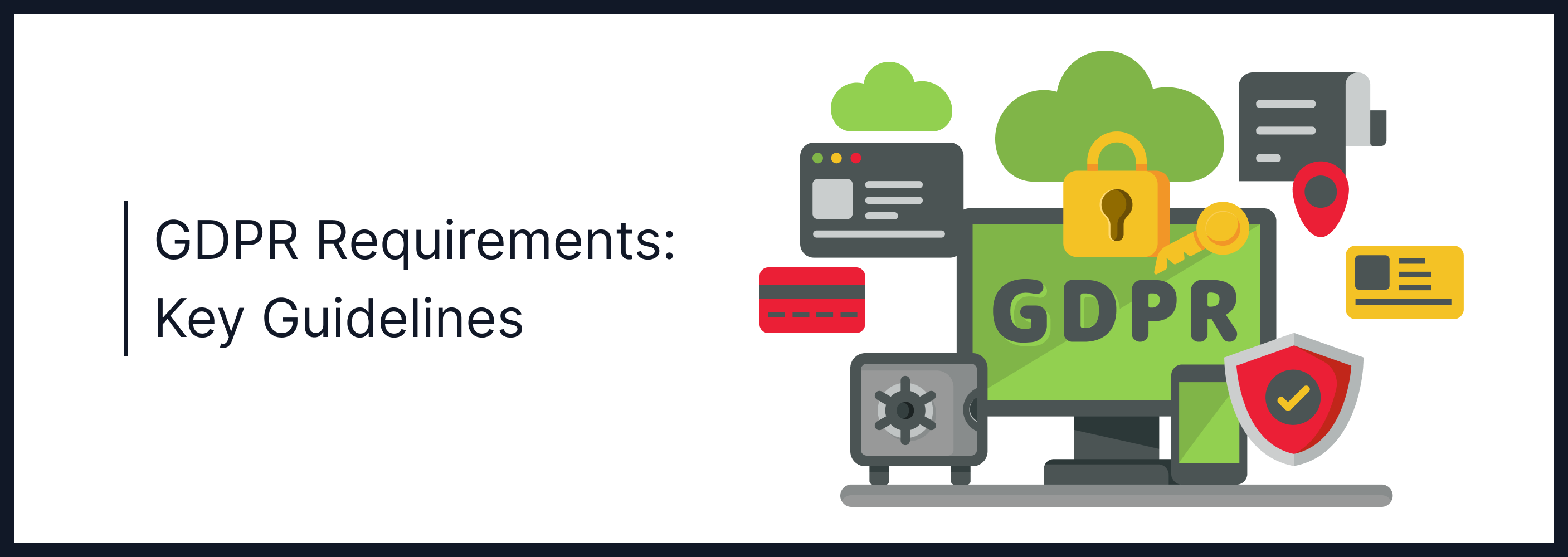
Oct 15, 2024 Information hub
GDPR Requirements: Key Guidelines for Businesses to Ensure Compliance
In today’s digital age, data is one of the most valuable assets for businesses. However, with the increasing reliance on data comes the responsibility to protect it. The General Data Protection Regulation (GDPR) is a legal framework that sets guidelines for the collection and processing of personal information from individuals who live in the European Union (EU). Since its enforcement in May 2018, GDPR has had a profound impact on how businesses handle data, not just in Europe but globally. Understanding GDPR requirements is crucial for any organization that processes personal data, whether it’s a small business or a multinational corporation. Non-compliance can lead to hefty fines, reputational damage, and loss of customer trust. In this blog post, we will explore the key GDPR requirements, their relevance today, practical examples, and the challenges businesses face in maintaining compliance.
What is GDPR and Why is it Important?
The General Data Protection Regulation (GDPR) is a regulation in EU law on data protection and privacy. It was designed to harmonize data privacy laws across Europe, protect EU citizens’ data privacy, and reshape the way organizations approach data privacy. GDPR applies to any organization that processes the personal data of EU citizens, regardless of where the organization is based.
Key Objectives of GDPR:
- To give individuals more control over their personal data.
- To simplify the regulatory environment for international businesses by unifying the regulation within the EU.
- To ensure that organizations are transparent about how they collect, store, and use personal data.
Why GDPR Matters Today
In 2023, GDPR remains as relevant as ever. With the rise of digital transformation, businesses are collecting more data than ever before. From e-commerce platforms to social media networks, personal data is being processed at an unprecedented scale. Moreover, the increasing number of data breaches and cyberattacks has made data protection a top priority for both businesses and consumers.
According to a report by IBM, the average cost of a data breach in 2022 was $4.35 million, a figure that continues to rise. GDPR aims to mitigate such risks by enforcing strict data protection measures. For businesses, compliance with GDPR is not just about avoiding fines; it’s about building trust with customers and ensuring long-term sustainability.
Key GDPR Requirements
GDPR is a comprehensive regulation, but there are several core requirements that businesses must adhere to. Let’s break down the most important GDPR requirements that organizations need to understand and implement.
1. Lawful, Fair, and Transparent Processing
Under GDPR, personal data must be processed lawfully, fairly, and in a transparent manner. This means that organizations must have a valid legal basis for processing personal data, and they must inform individuals about how their data will be used.
Legal Bases for Processing Data:
- Consent: The individual has given clear consent for their data to be processed for a specific purpose.
- Contract: Processing is necessary for the performance of a contract with the individual.
- Legal Obligation: Processing is necessary to comply with the law.
- Vital Interests: Processing is necessary to protect someone’s life.
- Public Task: Processing is necessary to perform a task in the public interest.
- Legitimate Interests: Processing is necessary for the legitimate interests of the organization, provided these interests are not overridden by the individual’s rights.
Practical Example:
An e-commerce website that collects customer data for order processing must inform customers about how their data will be used (e.g., for shipping, billing, and marketing purposes). The website must also obtain explicit consent if it plans to use the data for marketing purposes.
2. Data Minimization
GDPR requires organizations to collect only the data that is necessary for the specific purpose. This principle, known as data minimization, ensures that businesses do not collect excessive or irrelevant data.
Practical Example:
A mobile app that requires users to sign up should only ask for essential information such as name and email address. Asking for unnecessary details like home address or phone number, unless required for the app’s functionality, would violate the principle of data minimization.
3. Data Subject Rights
One of the most significant aspects of GDPR is the empowerment of individuals through data subject rights. These rights give individuals control over their personal data and how it is used.
Key Data Subject Rights:
- Right to Access: Individuals have the right to access their personal data and obtain information about how it is being processed.
- Right to Rectification: Individuals can request corrections to inaccurate or incomplete data.
- Right to Erasure (Right to be Forgotten): Individuals can request the deletion of their personal data under certain circumstances.
- Right to Restrict Processing: Individuals can request that their data be restricted from processing.
- Right to Data Portability: Individuals can request their data in a structured, commonly used format and transfer it to another organization.
- Right to Object: Individuals can object to the processing of their data for certain purposes, such as direct marketing.
Practical Example:
A customer of an online retailer can request access to all the personal data the retailer holds about them. If the customer finds inaccuracies, they can request corrections. Additionally, if the customer no longer wants the retailer to hold their data, they can request its deletion.
4. Data Breach Notification
GDPR mandates that organizations must notify the relevant supervisory authority of a data breach within 72 hours of becoming aware of it. If the breach poses a high risk to the rights and freedoms of individuals, the affected individuals must also be informed.
Practical Example:
In 2021, a major airline experienced a data breach that exposed the personal data of over 500,000 customers. The airline was required to notify both the supervisory authority and the affected customers within the stipulated time frame.
5. Accountability and Governance
GDPR places a strong emphasis on accountability. Organizations must not only comply with GDPR but also be able to demonstrate their compliance. This includes maintaining records of data processing activities, conducting data protection impact assessments (DPIAs), and appointing a Data Protection Officer (DPO) if necessary.
When is a DPO Required?
- If the organization is a public authority.
- If the organization engages in large-scale systematic monitoring of individuals (e.g., behavioral tracking).
- If the organization processes large amounts of sensitive personal data.
Practical Example:
A healthcare provider that processes sensitive health data on a large scale must appoint a DPO to oversee GDPR compliance and ensure that data protection measures are in place.
6. Data Protection by Design and Default
GDPR requires organizations to implement data protection measures from the outset of any project or system design. This is known as Data Protection by Design and Default. It ensures that privacy and data protection are considered at every stage of the data processing lifecycle.
Practical Example:
A software company developing a new customer relationship management (CRM) system must ensure that the system includes features such as encryption, access controls, and data anonymization to protect personal data.
Challenges in GDPR Compliance
While GDPR provides a robust framework for data protection, many organizations face challenges in achieving and maintaining compliance. Some of the common challenges include:
1. Complexity of Data Management
With the increasing volume of data being collected, managing and organizing data in a way that complies with GDPR can be overwhelming. Many organizations struggle to keep track of where personal data is stored, who has access to it, and how it is being used.
2. Cross-Border Data Transfers
GDPR places strict rules on transferring personal data outside the EU. Organizations that operate globally must ensure that they have appropriate safeguards in place, such as Standard Contractual Clauses (SCCs) or Binding Corporate Rules (BCRs), to transfer data to non-EU countries.
3. Evolving Cybersecurity Threats
As cyber threats continue to evolve, organizations must constantly update their security measures to protect personal data. Failure to do so can result in data breaches and non-compliance with GDPR’s security requirements.
4. Balancing Business Needs with Compliance
Many businesses struggle to balance their need for data-driven insights with GDPR’s strict data protection requirements. For example, marketing teams may want to collect as much data as possible to personalize customer experiences, but they must ensure that they do so in a way that complies with GDPR.
Benefits of GDPR Compliance
While GDPR compliance can be challenging, it also offers several benefits for businesses:
- Enhanced Customer Trust: By demonstrating a commitment to data protection, businesses can build trust with their customers, leading to stronger relationships and increased loyalty.
- Reduced Risk of Data Breaches: Implementing GDPR’s security requirements can help organizations reduce the risk of data breaches and the associated financial and reputational damage.
- Competitive Advantage: In a world where data privacy is increasingly important, businesses that prioritize GDPR compliance can differentiate themselves from competitors.
- Avoidance of Fines: Non-compliance with GDPR can result in fines of up to €20 million or 4% of global annual turnover, whichever is higher. By complying with GDPR, businesses can avoid these costly penalties.
Future Trends and Developments in GDPR
As data protection continues to evolve, several trends and developments are shaping the future of GDPR:
1. Increased Enforcement
Since its implementation, GDPR enforcement has been steadily increasing. In 2022, the European Data Protection Board (EDPB) reported a significant rise in fines, with over €1.1 billion in penalties issued. This trend is expected to continue as regulators become more proactive in enforcing GDPR.
2. Global Influence of GDPR
GDPR has set a global standard for data protection, and many countries outside the EU are adopting similar regulations. For example, Brazil’s Lei Geral de Proteção de Dados (LGPD) and California’s Consumer Privacy Act (CCPA) are heavily influenced by GDPR. As more countries implement data protection laws, businesses will need to navigate an increasingly complex regulatory landscape.
3. Focus on AI and Data Ethics
As artificial intelligence (AI) and machine learning become more prevalent, there is growing concern about how these technologies process personal data. GDPR’s principles of transparency, fairness, and accountability will play a crucial role in shaping the ethical use of AI in data processing.
Conclusion
GDPR has fundamentally changed the way businesses handle personal data, and its impact will continue to be felt for years to come. By understanding and implementing the key GDPR requirements, organizations can not only avoid fines but also build trust with their customers and gain a competitive edge.
To summarize, the key GDPR requirements include:
- Lawful, fair, and transparent processing.
- Data minimization.
- Respecting data subject rights.
- Timely data breach notifications.
- Accountability and governance.
- Data protection by design and default.
While GDPR compliance can be challenging, the benefits far outweigh the costs. By prioritizing data protection, businesses can safeguard their reputation, enhance customer trust, and ensure long-term success in an increasingly data-driven world.
Actionable Takeaways:
- Review your data processing activities to ensure they comply with GDPR’s legal bases.
- Implement data minimization practices to avoid collecting unnecessary data.
- Ensure that your organization respects data subject rights and has processes in place to respond to requests.
- Regularly update your cybersecurity measures to protect personal data from breaches.
- Appoint a Data Protection Officer (DPO) if required and maintain records of your data processing activities.
By taking these steps, your organization can stay compliant with GDPR and protect the personal data of your customers.
